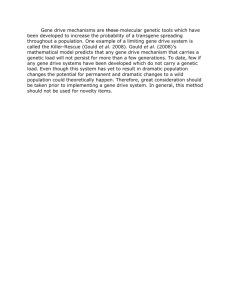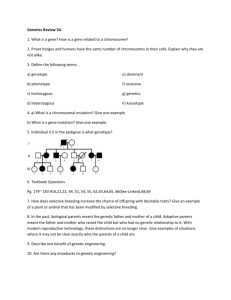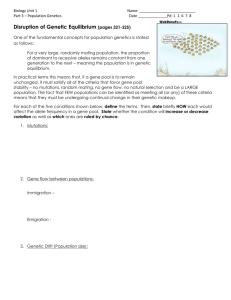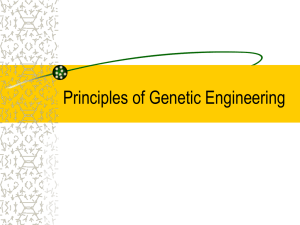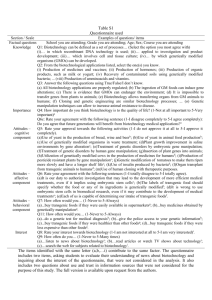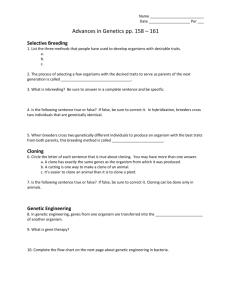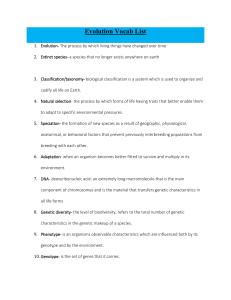Ethics
advertisement
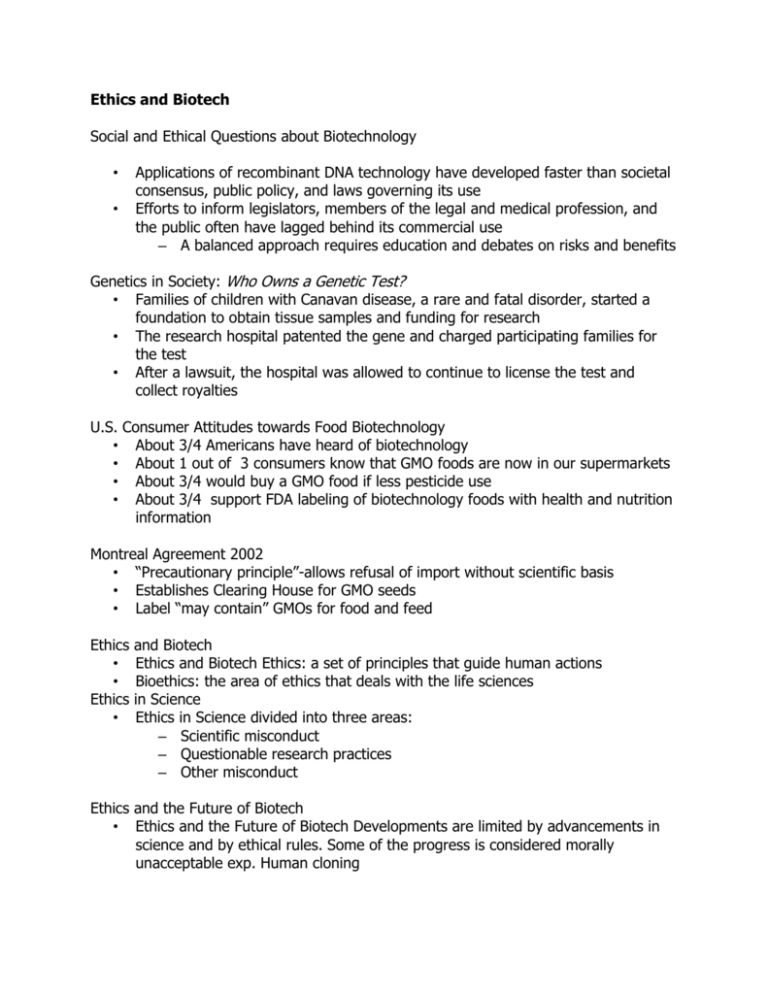
Ethics and Biotech Social and Ethical Questions about Biotechnology • • Applications of recombinant DNA technology have developed faster than societal consensus, public policy, and laws governing its use Efforts to inform legislators, members of the legal and medical profession, and the public often have lagged behind its commercial use – A balanced approach requires education and debates on risks and benefits Genetics in Society: Who Owns a Genetic Test? • Families of children with Canavan disease, a rare and fatal disorder, started a foundation to obtain tissue samples and funding for research • The research hospital patented the gene and charged participating families for the test • After a lawsuit, the hospital was allowed to continue to license the test and collect royalties U.S. Consumer Attitudes towards Food Biotechnology • About 3/4 Americans have heard of biotechnology • About 1 out of 3 consumers know that GMO foods are now in our supermarkets • About 3/4 would buy a GMO food if less pesticide use • About 3/4 support FDA labeling of biotechnology foods with health and nutrition information Montreal Agreement 2002 • “Precautionary principle”-allows refusal of import without scientific basis • Establishes Clearing House for GMO seeds • Label “may contain” GMOs for food and feed Ethics • • Ethics • and Biotech Ethics and Biotech Ethics: a set of principles that guide human actions Bioethics: the area of ethics that deals with the life sciences in Science Ethics in Science divided into three areas: – Scientific misconduct – Questionable research practices – Other misconduct Ethics and the Future of Biotech • Ethics and the Future of Biotech Developments are limited by advancements in science and by ethical rules. Some of the progress is considered morally unacceptable exp. Human cloning Biotechnology Feeds on New Paradigms of Bioscience • 1953: Structure of DNA as genetic material. • 1973: Genetic engineering (gene splicing)achieved. • Mid 90’s: Widespread genetically modified (GM) crops in market. • 1997: Animal cloning achieved. • 2001: Human genome unveiled. • New Millennium: Maturing of stem cell research and genomics (gene chips, proteomics, “transcriptomics”). • Technology is moving faster than understanding of implications to society Issues for the New Millennium • Cloning: – Therapeutic organ cloning (cost and equity> technical>moral) – Whole organism cloning (moral>technical) – Deciding factors: embryonic vs adult stem cells, failure rates, long-term issues • Genomics: – Pharmacogenomics (cost and equity) – GMOs (biosafety vs benefits) – Deciding factors: consumer benefits vs costs, understanding of long-term effects of GMOs on the environment Ethical, Social and Legal Implications • Is it against “nature”? Risks vs benefits? – Transgenics intrinsically harmful to the environment? Environmental biosafety concerns – Harmful to consumers? Health biosafety concerns • Gap between haves and have-nots increased Intellectual property system in favour of already developed countries (eg. gene patents). – Production system in favour of the already efficient Future Directions: Towards Good Governance in Biotechnology • Role of government: – Oversees development and capability strengthening in both technical and social, ethical issues in biotechnology and life sciences. – Set up regulations and laws as necesssary, making sure of having a healthy balance. • Role of civil societies (NGOs) – Help to make the public understand issues in various aspects, not just lobby on single issues. • Role of education/research institutes – Acquire knowledge and understanding on issues interfacing between technology and society. • • • • • • • • • • • • – Help to generate healthy debates among various stakeholders and the public. Social science surveys have documented that individuals are more risk averse about food than institutions, and there is widespread concern within the public about the risks of biotechnology, desire for more information about the risks themselves and the risk/benefit distribution of GM food, and a desire for choice in being exposed to risk. The introduction of so-called "wonder-products" such as DDT and PCBs and their subsequent withdrawal after unforeseen problems were discovered, has undermined public trust in companies that introduce products that are pervasively used, and in the government agencies meant to regulate them. There is also a widespread sense that social and technological change is speeding up and people feel powerless to affect this change; diffuse anxiety driven by this context becomes focused when it is food that is being changed. In 2006, the Pew Initiative on Food and Biotechnology made public a review of U.S. survey results from 2001-2006. The review showed that Americans' knowledge of genetically modified foods and animals was low through the period. An example of this ignorance (not cited in the Pew review), were protests against Calgene's Flavr Savr transgenic tomato that described the GM tomato as being made with fish genes, confusing it with DNA Plant Technology's Fish tomato experimental transgenic organism, which was never commercialized. The Pew survey also showed that despite continuing concerns about GM foods, American consumers do not support banning new uses of the technology, but rather seek an active role from regulators to ensure that new products are safe. A 2010 Deloitte survey found that 34% of U.S. consumers were very or extremely concerned about GM food, a 3% reduction from 2008. The same survey found a strong gender difference in opinion: 10% of men were extremely concerned, compared with 16% of women, and 16% of women were unconcerned, compared with 27% of men. A 2009 review article of European consumer polls concluded that opposition to GMOs in Europe has been gradually decreasing. Approximately half of European consumers accepted gene technology, particularly when benefits for consumers and for the environment could be linked to GMO products. 80% of respondents did not cite the application of GMOs in agriculture as a significant environmental problem. Many consumers seem unafraid of health risks from GMO products and most European consumers did not actively avoid GMO products while shopping. The 2010 "Eurobarometer" survey, which assesses public attitudes about biotech and the life sciences in Europe, found that "cisgenics, GM crops produced by adding only genes from the same species or from plants that are crossable by conventional breeding," evokes a different reaction than transgenic methods, where "genes are taken from other species or bacteria that are taxonomically very different from the gene recipient and transferred into plants." • A 2007 survey by the Food Standards Australia and New Zealand found that in Australia where labeling is mandatory, 27% of Australians looked at the label to see if it contained GM material when purchasing a grocery product for the first time And the other side (from the opposition) 7 reasons to never eat GMO foods --Increased Pesticide Use US government data shows that in the US, GM crops have produced an overall increase, not decrease, in pesticide use compared to conventional crops. “The promise was that you could use less chemicals and produce a greater yield. But let me tell you none of this is true.” -- Bill Christison, President of the US National Family Farm Coalition. Have Been Shown To Be Dangerous To Your Health and Unsafe To Eat Genetic modification is a crude and imprecise way of incorporating foreign genetic material (e.g. from viruses, bacteria) into crops, with unpredictable consequences. The resulting GM foods have undergone little rigorous and no long-term safety testing. However, animal feeding tests have shown that GM foods have toxic effects, including abnormal changes in organs, immune system disturbances, accelerated ageing, and changes in gene expression. Very few studies have been published on the direct effects on humans of eating a GM food. One such study found unexpected effects on gut bacteria, but was never followed up. It is claimed that Americans have eaten GM foods for years with no ill effects. But these foods are unlabeled in the US and no one has monitored the consequences. With other novel foods like trans fats, it has taken decades to realize that they have caused millions of premature deaths. --GM foods are an imminent threat to humanity's food supply. Besides the ethical concerns, genetic pollution is self-perpetuating. It can never be reversed or cleaned up. Genetic mistakes will be passed on to all future generations of a species. Wind, rain, birds, bees, and insect pollinators have begun carrying genetically-altered pollen into adjoining fields, polluting the DNA of crops of organic and non-GM farmers. This has been happening all over the world for more than a decade. Theoretically, it genetic pollution continues, it could obliterate the world's natural organic food supply. Use of herbicideresistant crops will also lead to a accelerated increase in the use of herbicides, resulting in even greater pollution of our food and water with toxic agrochemicals. “We are confronted with the most powerful technology the world has ever known, and it is being rapidly deployed with almost no thought whatsoever to its consequences.” -- Dr Suzanne Wuerthele, US Environmental Protection Agency (EPA) toxicologist --GM Foods Are Hidden In Animal Feed As a spokesperson for Asgrow, a subsidiary of Monsanto, said, "If you put a label on genetically engineered food, you might as well put a skull and crossbones on it." The GM industry has got around the problem of consumer rejection of GM foods by hiding them in animal feed. Meat, eggs and dairy products from animals raised on the millions of tons of GM feed imported into Europe do not have to be labelled. Some studies show that contrary to GM and food industry claims, animals raised on GM feed ARE different from those raised on non-GM feed. Other studies show that if GM crops are fed to animals, GM material can appear in the resulting products and affect the animals’ health. So eating these “stealth GMOs” may affect the health of consumers --GM and non-GM Cannot Co-Exist GM contamination of conventional and organic food is increasing. An unapproved GM rice that was grown for only one year in field trials was found to have extensively contaminated the US rice supply and seed stocks. In Canada, the organic oilseed rape industry has been destroyed by contamination from GM rape. In Spain, a study found that GM maize “has caused a drastic reduction in organic cultivations of this grain and is making their coexistence practically impossible”. The time has come to choose between a GM-based, or a non-GM-based, world food supply. Alfalfa is the main forage crop for dairy cows and one of the principle foods for beef cows, especially grass-fed cattle. Alfalfa is a perennial, easily lasting five years once planted. And it's bee-pollinated, which means each year, every nonGM alfalfa plant within five miles of every GM alfalfa plant will likely be contaminated by GM genes. “If some people are allowed to choose to grow, sell and consume GM foods, soon nobody will be able to choose food, or a biosphere, free of GM. It’s a one way choice, like the introduction of rabbits or cane toads to Australia; once it’s made, it can’t be reversed.” -- Roger Levett, specialist in sustainable development. --Long-term Economic Disaster For Farmers A 2009 report showed that GM seed prices in America have increased dramatically, compared to non-GM and organic seeds, cutting average farm incomes for US farmers growing GM crops. The report concluded, “At the present time there is a massive disconnect between the sometimes lofty rhetoric from those championing biotechnology as the proven path toward global food security and what is actually happening on farms in the US that have grown dependent on GM seeds and are now dealing with the consequences.” --GM Companies Cannot Be Trusted The big biotech firms pushing their GM foods have a terrible history of toxic contamination and public deception. GM is attractive to them because it gives them patents that allow monopoly control over the world’s food supply. They have taken to harassing and intimidating farmers for the “crime” of saving patented seed or “stealing” patented genes -- even if those genes got into the farmer’s fields through accidental contamination by wind or insects. Monsanto has been the largest player in the GM foods game. They have single handedly made the United States the world's biggest producer of GM foods, pesticides and herbicides. Founded in 1901, Monsanto has manufactured industrial chemicals (e.g. sulphuric acid), plastics and synthetics, and saccharin, a carcinogenic artificial sweetener. It has also produced or granted production licenses for most of the world's toxic PCB's which are now mostly banned worldwide. “Farmers are being sued for having GMOs on their property that they did not buy, do not want, will not use and cannot sell.” -- Tom Wiley, North Dakota farmer. --GM Foods Will Never Solve The Food Crisis A 2008 World Bank report concluded that increased biofuel production is the major cause of the increase in food prices. Biofuels are crops grown for fuel rather than food. GM giant Monsanto has been at the heart of the lobbying for biofuels -- while profiting enormously from the resulting food crisis and using it as a PR opportunity to promote GM foods! “The climate crisis was used to boost biofuels, helping to create the food crisis; and now the food crisis is being used to revive the fortunes of the GM industry.” -- Daniel Howden, Africa correspondent, The Independent (UK). “The cynic in me thinks that they’re just using the current food crisis and the fuel crisis as a springboard to push GM crops back on to the public agenda. I understand why they’re doing it, but the danger is that if they’re making these claims about GM crops solving the problem of drought or feeding the world, that’s bullshit.” -- Prof Denis Murphy, head of biotechnology, University of Glamorgan, Wales The United States is the leader in GM cultivation and now grows mostly GM varieties of corn, canola and soy. Hawaii now grows GM papayas. Approvals have also been given for GM alfalfa, zucchinis, beet sugar and tomato varieties, though not all are currently being grown. In 2010, the US planted 66.8 million hectares of soybean, maize, cotton, canola, squash, papaya, alfalfa and sugarbeet. The largest share of the GMO crops planted globally are owned by Monsanto. More than 30 of Monsanto's directors, CEOs, VPs, board members, managers, scientists, attorneys and consultants also hold Federal Positions within the US government. Canada has widespread GM crop usage. All Canadian canola is GM, as is a large portion of the country's soy and corn. Prince Edward Island tried to pass a ban on GMO cultivation but failed, and GM crops in the region are currently increasing. Despite the fact that 233 consumer and farmer groups in 26 countries have joined the "Definitive Global Rejection of GM Wheat", Canadian MPs voted to reject stronger export rules for crops of genetically modified organisms (GMOs). Genetics, biotechnology, and molecular biology are some of the fastest-growing and most controversial industries of our time. Using the latest developments in these areas, it is possible to sequence the entire human genome (this is the goal of the Human Genome Project); identify individuals from DNA fragments; determine a person's genotype (genetic makeup) for a variety of traits; and determine someone's individual likelihood to develop certain cancers, respiratory problems, and heart diseases. Gene therapy trials that focus on somatic (body) cells have already begun for several diseases, and many more are being planned. Germ-line therapy (alteration of reproductive cells for the purpose of eliminating defective genes) has been proposed, and has its supporters and opponents. Genetically engineered organisms that perform desirable functions have been releases into the environment. Many other uses for genetic engineering are in developmental stages, and thousands more are being proposed. These technologies have the power to shape the future of the entire human race. If used responsibly, they can improve the quality of life for millions of people; virtually eliminate genetic disease; vastly reduce the incidence of genetically-influenced diseases such as cancer and heart disease; and drastically reduce the amount of pollution in our environment. If used irresponsibly, they can lead to the development of "designer humans" for military use; allow parents to choose the physical and even mental attributes of their children; add further pollution to the already-taxed environment; and even permit the creation of biological weapons which could decimate the population not only of the target country, but of the entire globe. Ethics and Biotech The drastic consequences of irresponsible use of biotechnology mean that this technology must be monitored and regulated - virtually everyone agrees on this. The controversy arises when the degree of regulation comes into consideration. Some people want the technology banned altogether, while others want only very loose regulations mainly defined by biotechnology companies. Most people stand somewhere in between these two extreme positions. The "Ethics" series of pages on this site present a sampling of ethical and legal dilemmas raised by biotechnology, and include suggested solutions in the form of "Ethical Principles". Introduction to Genetic Screening Genetic screening is a process by which a population is tested to determine which individuals possess the gene for a certain genetic disease. Many developed countries, with varying degrees of success, have screened for sickle cell anemia, cystic fibrosis, Tay-Sachs disease, thalassemia, and the XYY genotype. The XYY Story Nondisjunction, a failure in the distribution of chromosomes during meiosis, sometimes causes the formation of a sperm cell with two Y chromosomes. When this abnormal sperm cell fertilizes an egg, it leads to the development of an otherwise normal boy with two Y chromosomes, instead of the usual one. The first patient to be discovered to have this genotype (this occurred in the 1960's) was known to be slightly aggressive - a fact that excited geneticists. "Could aggressive behavior in men be traced to 'XYY syndrome'?" they wondered. Patricia Jacobs, a British geneticist, with four other colleagues, did a study of 197 men in a high-security mental hospital in Scotland. The study, published in the British journal Nature in 1965, showed that 3.5 percent of the men studied had the XYY genotype. This is about 20 times higher than the normal occurrence of the defect. It was also noted that men in possession of the XYY genotype tended to be taller than ordinary men. The authors concluded their Nature article by stating it was not clear whether or not the XYY genotype "is related to aggressive behavior". Many geneticists of the time ignored this uncertain ending to Jacobs' study. They thought the Y chromosome, in addition to influencing male physical characteristics, also exerted a degree of control over mental characteristics like aggressiveness. More studies followed the original one by Jacobs, and most confirmed the high rates of XYY genotypes found in mental hospitals and prisons. These studies received a great deal of media coverage, sensationalizing the genotype's "aggressive influences". XYY Screening Countries such as the U.S., Canada, Denmark, and England began allowing maternity hospitals to test for XYY genotypes in babies. A study carried out by Stanley Walzer and Park Gerald tracked the development of XYY boys, keeping a watch for aggression or mental disturbance. Eventually, this study's morality and validity came under criticism from scientists and citizens. It was revealed that XYY studies consistently omitted a control group of normal XYY males, tended to downplay environmental factors that influence aggression and mental health, and simplistically defined complex behaviors such as aggression. Despite all the studies done on XYY men, there is no evidence that the genotype affects behavior in any way. This is just one example of misguided genetic screening that only leads to paranoia and panic. The Sickle-Cell Screening Fiasco Another example of misguided screening with disastrous results is the sickle-cell anemia screening carried out in the U.S. in the 1970's. Since screening regulations were left to be defined by the individual states, the program was inconsistent and sometimes discriminatory. Some states made the screening mandatory only for black people. Others, such as Massachusetts, declared that carriers of the sickle-cell trait were themselves diseased, leading to job discrimination and confusion over marriage and health insurance. PKU: A Screening Success Story PKU, or phenylketonuria, is a disease in which victims cannot digest the amino acid phenylalanine. The acid builds up in their brains and often results in mental retardation. It can be treated by putting affected children on a phenylalanine-free diet to the age of six, when the brain is developed enough to be undamaged. Also, women with PKU must stick to the diet while they are pregnant to avoid damage to the developing fetus. Maternity hospitals now regularly perform a simple test for the disease on all babies, so that affected children can be treated immediately. Lessons Learned From Screening Many valuable lessons have been learned from various screening programs carried out in many different countries. The best screening programs are well-funded and wellorganized. Good information is provided to participants, emphasizing the difference between carrying a certain disease and actually having it. For those discovered to be carriers, counseling is provided that explains the disease and its effects, defines options for treatment of victims, and explores methods of prenatal diagnosis if necessary. If these basic rules of good screening are followed, then confusion and discrimination is likely to be avoided, and people can make informed, intelligent lifestyle and reproductive choices. Introduction to Cloning Cloning is defined in The American Heritage Dictionary as "a replica of a DNA sequence, such as a gene, produced by genetic engineering". It is at once a fascinating and frightening aspect of biotechnology, and it is one of the most controversial scientific possibilities of our time. In 1997, a sheep named Dolly was supposedly cloned, making her the first "artificial" mammal on Earth. This event raised a large number of legal and ethical issues involving the technology, and caused some people to wonder about the merits of biotechnology as a whole. Cloning in itself is not unethical, or even uncommon - every time someone grows a new plant from a cutting, they are cloning a living organism. When molecular biologists use PCR (polymerase chain reaction) to amplify and study a piece of DNA, they are cloning genetic material. Neither of these ordinary events are in any way unethical. However, these examples are not major ethical concerns. It is the cloning of animals and humans that has many people worried. Cloning as a Reducer of Genetic Diversity When cloning technology was first proposed, many scientists had visions of vast herds of genetically identical livestock, selected and cloned for meat quality and disease resistance. These scientists saw fields of crops genetically manipulated for optimum output and pest resistance. While excellent ideas, these visions are neither feasible or desirable now or at any time in the future. Genetic diversity is the number of different genetic combinations available in a given gene pool. Humans have very high genetic diversity, because their are many genetic combinations available. Cheetahs have low genetic variability, because they are all virtually genetically identical. This makes them all susceptible to the same diseases and pests. Therefore, an epidemic of a disease to which they have low resistance could decimate the entire population, rather than just the susceptible individuals. Herds of cloned livestock and fields of cloned crops have the same potential problemas the cheetahs described above. Currently, livestock and crops have vast genetic resources available to them in the event of a disease epidemic. If humans engineer livestock and crops to be resistant to today's threatening diseases, we could remove the important genetic resources possessed by these organisms to resist new, novel diseases never before encountered. The results of this sort of "genetic mismanagement" could be disastrous. With genetically identical livestock and crops, a new disease could destroy 100% of the food resources of a given area, causing widespread famine and food shortages. Cloning as a Military Weapon It has been speculated that the cloning of humans could be employed to create an unstoppable "designer army". This army would be made up of genetically identical, enhanced individuals with great physical strength and artificial immunity to many diseases. The members of this hypothetical army would most likely be capable of enduring extreme physical hardship, and could even be "tailored" to the environment in which they were fighting. For example, an army sent to the tropics would be immune to tropical diseases and would be capable of fighting in extremely hot weather. An army sent to the Arctic Circle would be tolerant of exposure to very cold temperatures for long periods of time. Needless to say, this hypothetical scenario would be impossible to bring to fruition with today's technology. However, it is a possibility in the far future that has many people worried about developments in biotechnology. There is a need to monitor the biotechnology developments of all nations through an international peacekeeping agency such as the United Nations. Only open communication and careful regulation regarding biotechnology can keep this nightmare from becoming reality. Human Cloning The cloning of entire human beings for any reason is inherently unethical. It violates the "sanctity of life" philosophy held in some variety by almost every culture on the globe. It could lead to the "designer army" scenario described above. Cloning could reduce genetic diversity in humans, lowering the disease resistance of the human population as a whole. It could also lead to inbreeding among genetically similar or identical individuals, which results in higher incidence of birth defects and further reduction of genetic diversity. In addition, it could put great strain on the food resources of our already-overpopulated planet. For all these reasons, human cloning is the ultimate taboo, being considered unethical, illegal, and undesirable in scientific, political, and religious circles. Cloning as a Medical Tool The possibility exists to take human DNA and clone specific organs or body parts, such as the liver, spine, or skin. This type of cloning cannot be seen as anything but a good thing. It could save thousands of lives by replacing damaged organs or body parts - for example, cloning skin for a burn victim, a spine for a paraplegic, or a liver for a hepatitis victim. This technology could vastly reduce the demand for donated organs while simultaneously eliminating the possibility of organ rejection. In addition, it would eliminate the need for immunosuppressive drugs that render organ recipients vulnerable to common diseases. The technology is not currently available, but is being studied. Introduction to Biological Weapons Is defined as "the deliberate use of microorganisms or toxic substance derived from living cells for hostile purposes". Biological warfare is generally regarded as highly unethical and morally repulsive. The United States government considers a biological attack to be on par with the detonation of a nuclear device. Many of the diseases most easily adapted to military use are diseases which have ravaged the human population for centuries. Among those considered promising candidates are respiratory anthrax (fatal); pneumonic plague (fatal, respiratory form of bubonic plague); tularemia (formerly standard American lethal biological agent until destruction of U.S. stockpiles, 40% fatal); and smallpox (fatal in unvaccinated individuals). Modification of Biological Agents Though the bacteria, viruses, and fungi considered good candidates for military use are virulent enough on their own, it is possible to modify these pathogens, making them even more efficient at killing or incapacitating enemy populations. Recombinant DNA techniques could lead to the development of longer-lived, more virulent germs better able to withstand "weaponized" conditions inside a bomb or floating through the air over enemy territory. Another ghastly application of genetic engineering to biological warfare, first proposed in 1970 in the American military journal Military Review,, involves the exploitation of subtle hereditary differences between ethnic populations. A pathogen would be modified so it would be most likely to infect people of a particular ethnic background, leaving those of other ethnicities relatively unharmed. The ultimate in racial discrimination, these tactic has the potential to virtually eliminate certain ethnic groups while leaving others untouched. Introduction to Gene Therapy Gene therapy, the therapeutic replacement or repair of abnormal genes in human cells, is one of the most promising and controversial innovations in biotechnology. Though gene therapy is possible in the near future for only monogenic diseases (those caused by one gene), the technique holds enormous possibilities in the distant future for correcting more complex diseases. Gene Therapy Techniques There are three main categories of gene therapy techniques. The first, gene insertion, is the only one that is possible in the near future. It involves simply adding the normal version of a defective gene to the genome of the affected cells. When this gene is expressed, it could produce sufficient quantities of a missing or defective protein or enzyme, thus "curing" the disease. This method could potentially be dangerous, however, because a randomly added genetic sequence could disrupt the function of another vital sequence. For this reason, the other two methods are being looked into as ideal future methods of gene therapy. The second approach, gene modification, entails the direct chemical modification of of the abnormal DNA sequence in an effort to duplicate the normal sequence in an abnormal cell. This strategy is much less likely to disrupt the function of other genes because no new sequences are introduced. The third approach, called gene surgery, is considered to be the ultimate goal of gene therapy. It involves the removal of the precise genetic sequence that is defective, and replacing it with a cloned copy of the normally functioning sequence. This strategy is the least likely to cause unwanted side effects, but it is also the most advanced and therefore is not possible in the near future. Using the Gene-Insertion Strategy There are several different ways of inserting a normal copy of a gene into the defective genome of a cell. All these approaches use vectors, or a "vehicle" used to get foreign DNA sequences into living cells. The most popular vectors are retroviruses, or viruses whose genetic information is encoded in RNA. Retrovirus Vectors A retrovirus works by infecting a host cell, then using the enzyme reverse transcriptase to use its RNA as a template for making DNA which then becomes integrated into the host cell's chromosomal DNA. The virus can then direct the formation of more viruses. The fact that retroviruses integrate their genetic material into that of the host cell makes them ideal for gene therapy, because they efficiently convey gees into the target cell. When retroviruses are used as vectors, a scientist removes the viral genes and replaces them with therapeutic genes. The virus then transfers these genes, instead of the virus genes, into the target cell; however, the virus is no longer capable of replicating itself. This technique is simple and possible in the near future; however, it has many limitations. The viruses can only accept a certain amount of base pairs, limiting the size of therapeutic genes to be transferred.In addition, the genetic information is randomly inserted into the host cell's genome, creating the possibility of disrupting the function of vital genes. There also exists a concern that the virus might not be completely "deactivated", and a patient might be inadvertently infected with a viral disease. Other Insertion Techniques Gene therapy that targets blood-cell disorders, such as sickle-cell anemia or inherited immune deficiencies, could be focused on bone-marrow cells known as stem cells. Current techniques for gene therapy of these disorders require new treatments every few months, because the genetically altered blood cells die off. By altering the stem cells, which carry a full genetic complement and give rise to new blood cells to replace those that die, one treatment in a lifetime would be enough. Despite the efforts of scientists, these stem cells remain elusive and difficult to genetically alter. Some scientists, concerned about the dangers of using viral vectors, have proposed creating an artificial chromosome and inserting that into target cells. These scientists have suggested coating a manmade chromosome in natural proteins, inserting it into a target cell, and allowing it to express its lifesaving genes. Gene Therapy Successes In 1988, researchers began the first test that would definitively show whether foreign genes, implanted into a human, were as dangerous as some people predicted. Genes for antibiotic resistance were implanted in blood cells called TILs (tumorinfiltrating lymphocytes). These modified cells were then given to a 52-year-old man with malignant melanoma (a fatal skin cancer) which had spread to his liver. He was told he had two months to live. The man received the TILs and lived for nearly a year after the treatment in May 1989 - much longer than previously expected. The genetically altered cells were detectable in the man's body up to three months after the injection. Most importantly, this landmark case proved that foreign DNA could be introduced into humans with no adverse effects, and paved the way for more advanced trials in the future. The first true gene therapy took place in 1990, with the treatment of two young girls who suffered from ADA (adenosine deaminase) deficiency, a rare type of immune disorder. Victims of the disease have high risk of cancer and are highly vulnerable to infection. In this trial, viral vectors carried ADA genes into white blood cells known as Tcells, which were then released into the girls' bodies. The cells produced the enzyme at about 25% of normal, which is enough to reverse the effects of ADA deficiency. The technique is not perfect - it requires regular infusions of T-cells - but it vastly improved the quality of life for the girls who were the first test subjects. Future Gene Therapy Candidates There are many possible candidate diseases for gene therapy, most of which ar rare, but some of which are fairly common. Diseases targeted for future gene therapy include cystic fibrosis, a disorder of the secretory cells common in Caucasians; sicklecell anemia, a hemoglobin disorder common in people of African descent; Lesch-Nyhan syndrome, a disease that causes retardation and a self-mutilating tendency; and familial hypercholesterolemia, a disease in which the ability to absorb a type of cholesterol is reduced in carriers and absent in full-blown victims. All these diseases have been researched by biotechnology companies as potential gene therapy candidates. In addition, the possibility of infecting tumor cells with viruses that render such cells vulnerable to destruction by normally harmless chemicals is also being studied. Somatic Cell vs. Germ Cell Therapy All the gene therapy techniques discussed so far have been aimed at somatic, or bodily, cells. These techniques can help individuals with genetic diseases, but do nothing for their offspring. It has been suggested that the same gene therapy techniques applied to somatic cells could be applied to germ cells, or reproductive cells (eggs and sperm),and eliminate certain genetic diseases from the population (with the exception of spontaneous mutation, which is very rare). This possibility has been vehemently opposed by many religious and scientific groups, but is also one of the most attractive applications of gene therapy. The idea of removing, say, the gene for Huntington's chorea from the human population doesn't seem like it could possibly be a bad idea. After all, Huntington's chorea is one of the most tragic genetic diseases known to mankind. However, many scientists express a concern that random insertion of replacement genes into germ cells could disrupt vital genes and create a predisposition to cancer in the unborn child. (In this case, a predisposition to cancer seems the lesser of two evils, since Huntington's is fatal to all those who inherit the gene.) Needless to say, germ-cell therapy needs to be scrupulously tested to guard against causing other diseases or cancer risks in children born of altered cells. Currently, genetherapy technology is not advanced enough to attempt germ-cell therapy. A Slippery Slope Many people see germ-line gene therapy as the beginning of humanity's descent down a slippery slope. They worry that people with genetic diseases will be stigmatized as "flawed" in a Nazi-style quest for genetic purity. In addition, they wonder if, after genetic diseases are dubbed "flaws", other traits such as nearsightedness, shortness, or athletic and academic inability will also be engineered out of the population. In this scenario, it is possible for parents to choose their child's gender, physical appearance, athletic ability, and academic proficiency. This scenario, though unlikely, is extremely dangerous - it could disrupt the gender balance of the population, lead to an extreme loss of genetic diversity, and ultimately even lead to an increase in genetic diseases because so many engineered children possess the same "desirable" genes that inbreeding becomes a problem. Also, by eliminating certain "undesirable" traits (such as sickle-cell trait), we could eliminate important adaptations to certain environments. (Elimination of sickle cell trait would probably lead to an increase in malaria, since it confers natural resistance to the disease.) Environmental Issues There are many environmental issues surrounding the agricultural, farming, and ecological applications of biotechnology. Many people question the wisdom of keeping genetically altered livestock, citing the possibility that the altered genes might escape into wild gene pools, where they might have undesirable effects. Objectors to altered crops express similar concerns, also wondering how engineered pest and herbicide resistance might affect local ecology. For example, they ask if herbicide resistance would lead to increased use of dangerous herbicides to kill weeds, since farmers would no longer worry about the dangers of their crops' overexposure to these chemicals. In addition, these people express concern that depriving insects of crops for food would, in turn, deprive birds and frogs of insect prey. There are also many objections to the release of genetically engineered organisms into the wild. Environmentalists express misgivings about the effects of introducing new and novel organisms into a given ecological systems. They say that the effects of new organisms - or even ordinary ones with new genes - are too complex to be predicted, and potentially too dangerous to be risked. Pros and Cons of Genetically Altered Livestock Livestock could, in theory, be genetically altered to give maximum output at minimum cost to farmers. Cows could be engineered for high milk production or high meat output, depending on their intended function. Sheep could be engineered for optimum wool growth, and pigs could be altered to have large amounts of meat with a minimum of fat. Advantages of this livestock specification are obvious and immediate: lower costs for manufacturers, lower prices for consumers, and higher output on the part of the animals. Disadvantages are more nebulous: a reduction in genetic diversity; potential and unforeseen health problems from genetically altered products. Some people even object to the ethics of the actual alterations, saying that it is wrong to view animals as production machines for food. Pros and Cons of Genetically Altered Crops Crops could be genetically altered for resistance to drought, frost, pests, disease, and herbicides. As stated above, there are many questions about the ecological impact of these alterations. The addition of any genes into crops could result in these genes' escape into the wild. (This is more of a danger for crops, whose seeds could spread off the farm, than it is for livestock.) Ecologists are uneasy about adding herbicide resistance to crops, fearing that this will eliminate any desire on the part of the farmers to refrain from using too many chemicals, which could affect wild animals. In addition, the concern exists that disease resistance could cause relatively harmless diseases to mutate and become more dangerous, perhaps even infecting humans. Pest resistance also could kill off insects, depriving birds and frogs of food, which could lead to a dangerous imbalance in the ecology of an area. Health Problems Associated with Transgenic Livestock and Crops Scientists are always searching for genes coding for enzymes and proteins that can be profitably spliced into livestock and crops. These genes confer pest and disease resistance and tolerance of pollution, and often increase the lifespan of livestock or growth rate of crops. However, there are certain health risks involved in this practice. For example, some people have a food allergy known as favism that causes an adverse reaction to the protein lectin, found in beans and other leguminous crops. Since lectin discourages aphids, common insect pests, from feeding on beans, the gene for making lectin has recently been engineered into potatoes. People with favism, unknowingly eating these transgenic potatoes, could have an allergic reaction to them. Other health concerns include the question that antibiotic resistance, engineered into foods as a marker, might transfer to the consumers eating the food. These resistant genes could be incorporated into bacteria, against whose diseases we would then be defenseless. (Scientists are working on more benign markers, such as color change or metabolic deficiencies.) Labeling Transgenic Foods To prevent the health problems described above, transgenic foods should always be labeled as such, with added enzymes or proteins listed clearly. Currently, transgenic foods are not required to be separated from ordinary crops and livestock. As a result, the health problems delineated above could potentially occur. Genetic Engineering Helps the Environment The planetary environment today is highly polluted by chemicals, heavy metals, oil products, and various other pollutants. Genetic engineering could change that. Already, genetically engineered oil-consuming bacteria have been released into the wild to clean up disastrous oil spills at sea and on land. Microbes that break down toxic pollutants and heavy metals commonly found near industrial sites have often been researched. These processes, called bioremediation, represent a fraction of what has been called "the most cost-effective means of ridding the earth of its accumulated pollutants". (Biotechnology Unzipped: Promises and Realities, by Eric S. Grace) Genetically engineered microbes can also be used to: monitor environmental conditions in highly polluted areas; add to the output of low-grade mines by filtering precious metals from other substances; clean up contaminated areas around worked-out mines; and decontaminate areas of low-level nuclear waste. Concerns Regarding the Release of Transgenic Organisms Into the Wild Many ecologists strongly object to the release of transgenic organisms into the wild, citing loss of genetic diversity, contamination of wild gene pools, and potential mutations as reasons. They say that engineering, say, a human gene into a microbe and releasing it into the environment contaminates the microbial species' natural gene pool. If the human gene is successful or beneficial in the wild, it could spread through the population, eliminating natural genes. Also, since microbial species often exchange genes through rings of DNA called plasmids, the concern exists that the gene could find its way into another species and there mutate, forming a new and novel disease against which humanity has no defense. Though these risks are small, they do exist, and thorough testing of transgenic species to be released should be carried out before the release.
